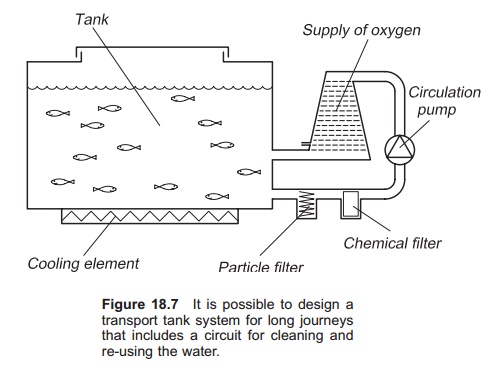Chapter: Aquaculture Engineering : Transport of Live Fish
Cleaning and re-use of water - Transport of Live Fish
Cleaning and re-use of water
In some situations it can be necessary to transport live fish over large distances and for longer periods of time (12–16 h). In these
circumstances there must be either a water exchange or continuous flow-through
of water as in well boats, depending of the species being transported. It is,
however, also possible to design a transport tank system that includes a
circuit for cleaning and re-using the water (Fig. 18.7) so that high
concentrations of carbon dioxide and ammonia in the water can be avoided. Such
transport tanks really function as a recycling plant with 100% re-use of water.
Complete removal of metabolic waste products is impossible from an economic
view, so even here the water quality will gradually decrease, but over a much
longer time period. Compared to a re-use plant, the degeneration of the water
quality will be slower because fish respiration is reduced due to prior
starvation.

Airlift pumps may be used for
removal of carbon dioxide in addition to adding oxygen and creating water flow.
Biofilters are not efficient systems for removal of TAN during transport
because these are biodynamic systems that require a start-up time to establish
a culture of bacteria before use. However, an ion exchanger can be used to
remove ammonia. When the water passes through the ion exchanger the ammonia is
removed (NH4+ exchanged with Na+); after use the ion exchanger must be regenerated, and this can
be done between journeys.
Long journeys and high degrees of
water circulation may also cause the water temperature to increase as a result
of the pumping required for water re-use and fish metabolism. Installation of a
cooling system on the transport tank can therefore be advantageous. The oxygen
supplied to the water
In Norway salmon smolt and
juvenile turbot have been transported for up to 5 days without water exchange
using a specially designed tank with a water re-use system.
Related Topics